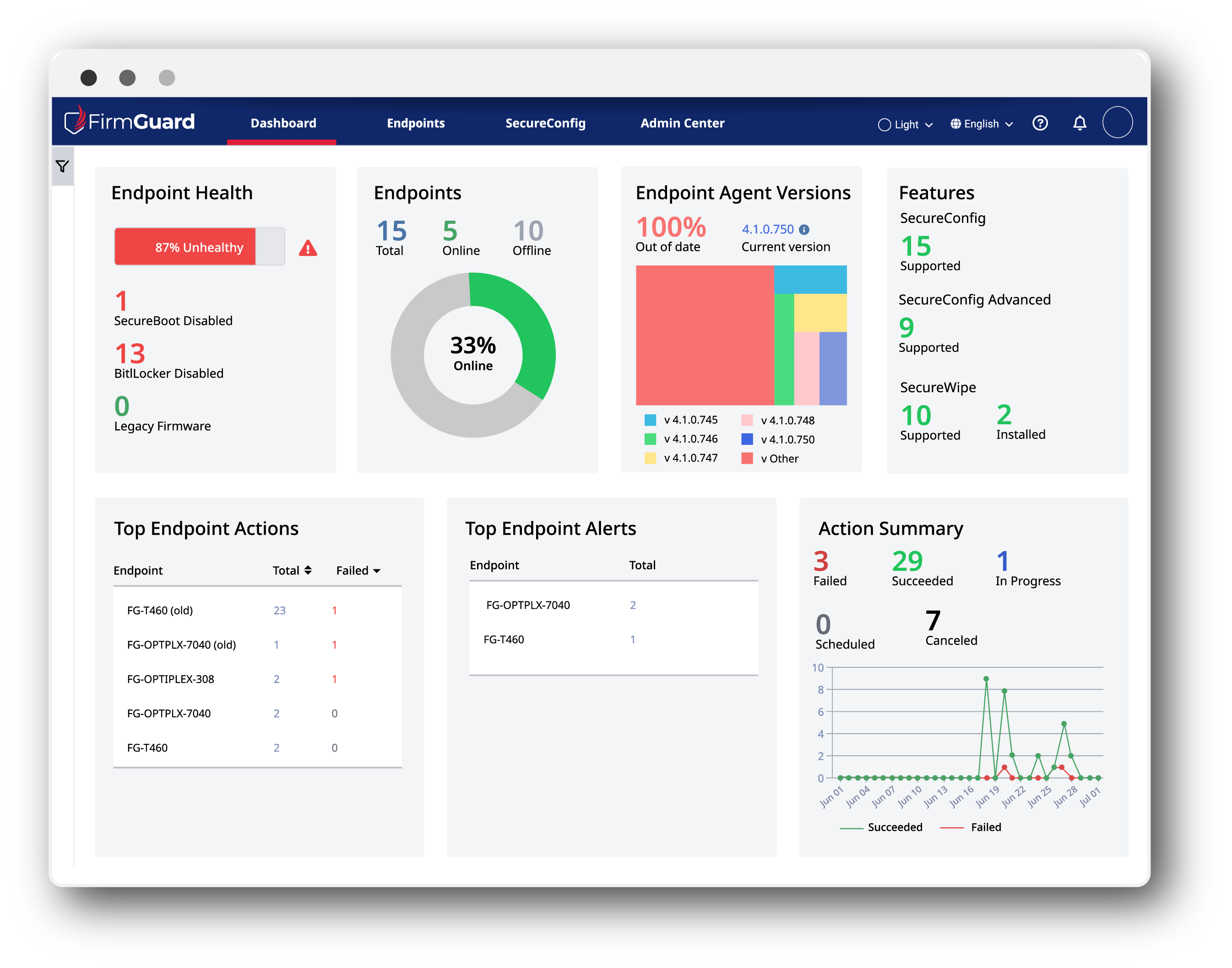Most MSPs and IT teams feel confident that their endpoint security stack is rock solid because they are protecting the operating system and applications with EDR tools and regularly patch systems to keep them up to date. But there’s one foundational layer that often flies under the radar but is vital to protect: BIOS firmware.
BIOS (the modern standard is called UEFI) is the firmware that initializes hardware before the operating system even starts. If this layer is compromised, it can render all other security measures useless, opening the door to stealthy, persistent threats that are extremely hard to detect and remove. Despite its critical role, BIOS security is often overlooked, leaving a massive blind spot in many organizations’ endpoint security strategy.
At FirmGuard, we believe securing the BIOS is not just a nice-to-have—it’s essential. That’s why we developed solutions like SecureUpdate and SecureCheck to help MSPs proactively monitor, manage, and secure BIOS firmware across their entire client base. In this post, we’ll break down why BIOS monitoring is crucial, how outdated firmware puts your clients at risk, and how you can seamlessly close this security gap to stay ahead of emerging threats.
The Risk of Outdated Firmware
Keeping endpoint operating systems and applications updated is standard practice, but what about the BIOS? For many MSPs, BIOS updates fall into a gray area: They’re easy to overlook, difficult to manage manually, and often assumed to be handled by manufacturer tools. Unfortunately, this assumption can leave systems exposed to serious vulnerabilities.
Outdated BIOS firmware can open the door to a range of security threats. Firmware exploits like BlackLotus and LogoFail have shown just how dangerous unpatched BIOS can be, allowing attackers to bypass traditional security layers and establish deep persistence on compromised devices. Even worse, because BIOS operates below the OS, these attacks often go undetected by conventional EDR and antivirus tools.
Adversaries have demonstrated that they already know how to exploit UEFI components for persistence, and they will only get better with practice
Beyond security risks, outdated BIOS can also create compliance headaches. Industry standards from NIST and ISO emphasize the importance of securing all layers of the system, including firmware. Falling behind on BIOS updates could mean falling out of compliance, exposing your clients to penalties, audits, or increased cyber insurance costs.
That’s where FirmGuard SecureUpdate makes a measurable difference. It continuously monitors BIOS versions across all managed devices, irrespective of manufacturer, and proactively alerts IT admins when updates are available. No more guessing games or scrambling to check each device manually. With SecureUpdate, your team can ensure every endpoint stays protected with the latest BIOS firmware. This helps close a critical security gap without overburdening already stretched IT staff.
Need a real-world example? ASC Group, a leading IT services provider, turned to FirmGuard to tackle this challenge. Facing growing compliance demands and an expanding client base, ASC Group needed a way to centrally manage BIOS updates across hundreds of devices. ASC clients already had a pre-defined maintenance window that was used to perform OS and application updates, so BIOS updates fit seamlessly into that window with almost no additional effort. This simple adjustment to a normal operating procedure reduced risk significantly and ensured consistent compliance.
Proactive Protection with SecureCheck
While keeping BIOS firmware updated is crucial, knowing your current security posture is just as important. Many MSPs assume their endpoints are secure, but without regular monitoring, hidden vulnerabilities can go unnoticed until it’s too late.
That’s where SecureCheck steps in. SecureCheck is like “antivirus for your BIOS firmware.” It continuously monitors the BIOS and alerts administrators when changes occur (both good and bad). For example, if an endpoint is legitimately updated with new UEFI BIOS firmware, the FirmGuard administrator will be made aware, though no action is required. In the event an endpoint is infected with UEFI related malware (e.g., bootkit or rootkit), SecureCheck will alert the administrator of unexpected changes and recommend remediation actions to resolve the situation. With SecureCheck in place, administrators can rest assured that they have closed one of the last remaining major open holes for endpoint exploitation.
The best part? SecureCheck helps you shift from reactive to proactive security. Instead of waiting for vulnerabilities to be exploited, you’re staying ahead of threats, protecting your clients’ infrastructure before issues arise.
The Business Case for MSPs
For MSPs, endpoint security isn’t just about protecting clients, it’s also about building a sustainable, profitable business. BIOS firmware security offers a powerful opportunity to do both.
First, let’s talk about technician efficiency. Managing BIOS firmware manually, especially across a dispersed fleet of devices, is time-consuming and prone to errors. With tools like SecureUpdate and SecureCheck, your team can remotely monitor, update, and audit BIOS firmware from a centralized dashboard. This means fewer site visits, faster issue resolution, and more time for your technicians to focus on higher-value tasks.
Second, BIOS security can unlock new revenue streams. Just like EDR and related services, BIOS monitoring and protection can be packaged as a premium add-on or bundled into existing managed service offerings. By filling this critical gap in your security stack, you can position your firm as a leader in comprehensive endpoint protection and justify higher MRR in the process.
Let’s look at a sample ROI: An MSP managing 500 endpoints charges an additional $3 per endpoint per month for BIOS monitoring and protection. That’s an extra $1,500 in monthly recurring revenue ($18,000 per year) generated with minimal additional technician effort, thanks to FirmGuard.
Finally, offering BIOS security is a competitive differentiator. Many MSPs still overlook this foundational layer, which means you have an opportunity to stand out in a crowded market. Clients are increasingly savvy about security, and when you demonstrate that you’re safeguarding their systems down to the firmware level, you build trust, loyalty, and a stronger long-term relationship.
Conclusion
As cybersecurity threats evolve, it’s clear that true endpoint protection must go deeper than the operating system. BIOS is the bedrock of every device—and if it’s left unmonitored or outdated, it creates a serious vulnerability that can undermine all other security efforts.
With tools like SecureUpdate and SecureCheck, FirmGuard empowers IT teams to proactively secure this critical layer. Whether it’s keeping BIOS firmware up to date or auditing the security posture across your client base, you can confidently close a major gap in your service offering. This in turn boosts compliance, improves technician efficiency, and drives new revenue opportunities.
The message is simple: BIOS monitoring is no longer optional. It’s essential for any IT team looking to provide comprehensive endpoint protection and stand out in a competitive market.







